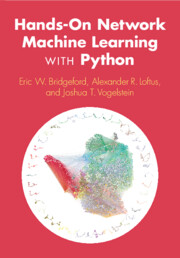Book contents
- Frontmatter
- Contents
- Preface
- Terminology
- Part I Foundations
- 1 The Network Machine Learning Landscape
- 2 End-to-End Biology Network Machine Learning Project
- Part II Representations
- Part III Applications
- Appendix A Network Model Theory
- Appendix B Learning Representations Theory
- Appendix C Overview of Machine Learning Techniques
- Index
1 - The Network Machine Learning Landscape
from Part I - Foundations
Published online by Cambridge University Press: 23 September 2025
- Frontmatter
- Contents
- Preface
- Terminology
- Part I Foundations
- 1 The Network Machine Learning Landscape
- 2 End-to-End Biology Network Machine Learning Project
- Part II Representations
- Part III Applications
- Appendix A Network Model Theory
- Appendix B Learning Representations Theory
- Appendix C Overview of Machine Learning Techniques
- Index
Summary
This chapter introduces the network machine learning landscape, bridging traditional machine learning with network-specific approaches. It defines networks, contrasts them with tabular data structures, and explains their ubiquity in various domains. The chapter outlines different types of network learning systems, including single vs. multiple network, attributed vs. non-attributed, and model-based vs. non-model-based approaches. It also discusses the scope of network analysis, from individual edges to entire networks. The chapter concludes by addressing key challenges in network machine learning, such as imperfect observations, partial network visibility, and sample limitations. Throughout, it emphasizes the importance of statistical learning in generalizing findings from network samples to broader populations, setting the stage for more advanced concepts in subsequent chapters.
Information
- Type
- Chapter
- Information
- Hands-On Network Machine Learning with Python , pp. 3 - 18Publisher: Cambridge University PressPrint publication year: 2025
Accessibility standard: WCAG 2.1 A
Why this information is here
This section outlines the accessibility features of this content - including support for screen readers, full keyboard navigation and high-contrast display options. This may not be relevant for you.Accessibility Information
Content Navigation
Allows you to navigate directly to chapters, sections, or non‐text items through a linked table of contents, reducing the need for extensive scrolling.
Provides an interactive index, letting you go straight to where a term or subject appears in the text without manual searching.
Reading Order & Textual Equivalents
You will encounter all content (including footnotes, captions, etc.) in a clear, sequential flow, making it easier to follow with assistive tools like screen readers.
You get concise descriptions (for images, charts, or media clips), ensuring you do not miss crucial information when visual or audio elements are not accessible.
